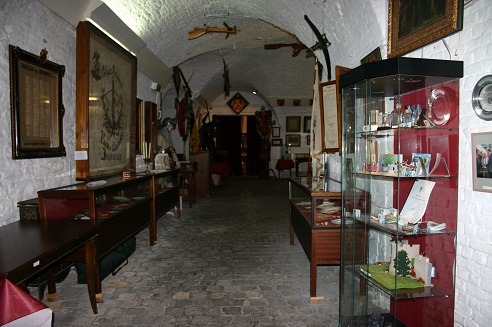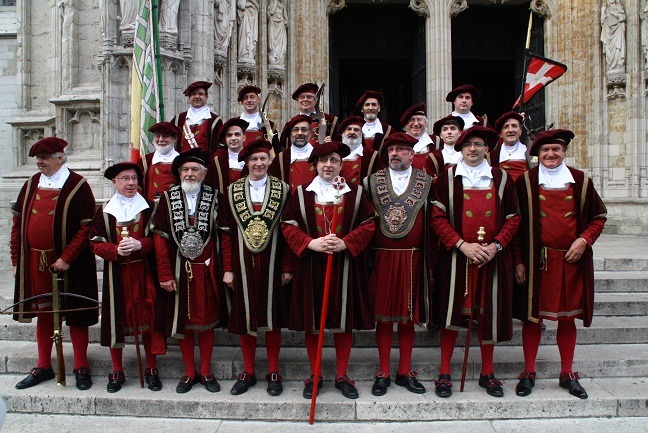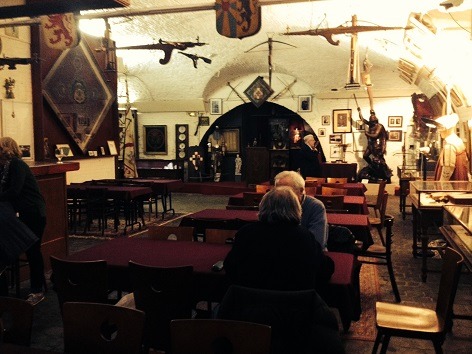Not many people know about the Crossbow Guild Museum. It is hidden behind a gate on Place Royale that is normally locked. Inside this strange museum are relics of an ancient Brussels corporation that dates back more than 600 years. You find many odd and obscure organisations in Brussels. There is the Order of the Manneken Pis, the Order of the Bloempanch (Black Sausage) and the Order of the Caricole (Boiled Sea Snail). Some seem a bit frivolous, but the Guild of Crossbowmen was charged with the serious task of defending the city from attack.
Founded in 1380, the Grand Serment Royal et de St-Georges des Arbalétriers de Bruxelles – the Royal Grand Order of Crossbowmen of St George of Brussels – is currently headquartered in a series of dark vaulted cellars below the royal church on Place Royale.
You need to come here on a Thursday evening if you want to see what lies hidden at the end of the alley known as Impasse du Borgendael. This cold, hidden building with a cobbled floor was originally a complex of stables where guests staying at the grand hotels on Place Royale could leave their horses and carriages.

The headquarter of the guild and its museum is located in a series of dark vaulted cellars below the royal church on Place Royal.
The crossbowmen used to practise their skills in an exercise yard on the north side of Place Royale. But they were forced to move out in the early 20th century when the entire neighbourhood was demolished to put up the Palais des Beaux-Arts. The hotels no longer needed the stables, so the guild moved in here.
The entrance is located on a little square under the walls of the Coudenberg church. I was greeted by an older man dressed in the red and maroon livery of the crossbowmen. He pointed out a secret passage that ran from the palace to the church. “That was built for King Léopold II so he could get into the church,” the guide explained. “He was afraid of being attacked if he went out into the streets.”
The man in the colourful costume was happy to stand for twenty minutes on a cold January night explaining the history of his guild. It was founded in the early Middle Ages when cities began to organise their own defence. Along with the swordsmen and the archers, the crossbowmen were armed citizens trained to protect the city’s independence.
As technology developed, the crossbowmen became increasingly obsolete. But the Grand Serment has miraculously survived, one of those relics of the distant past that cling on in Brussels, like sour Cantillon beer and the stretch of old city wall next to Crosly bowling alley.

Every year, the members of the Royal Grand Order of Crossbowmen of St George of Brussels, take part in the Ommegang parade. The order was so powerful that in the 15th century, it turned their little chapel in Sablon into one of the most beautiful Gothic churches in the city. Visitors can still see images of the crossbowmen in the stained glasses inside the church.
The 85 members (now including a few women) gather in the vaulted cellars on Thursday evenings to practise their skills on the firing range. It’s fascinating to watch them pull back the bow with a curious pronged device, aim the weapon and then release the catch. They practise on three ranges with targets set at six, ten and 20 metres.
The dark brick rooms are filled with a rich collection of 1,500 pieces dating back several hundred years. You come across old armour, crossbows hung from the ceiling and shiny trophies won in national competitions. You also see paintings, photographs, flags and posters. But the best thing about this place is that you get to chat to the members about their passion. They might even let you handle one of the solid wood crossbows.
By the 15th century, the company of crossbowmen had become more a rich man’s club than a fighting force. They poured money into the transformation of their little chapel on the Sablon, turning it into one of the most beautiful Gothic churches in the city. The crossbow guild would assemble here every year on Ascension Day to parade in their fine costumes.
The collection includes paintings that show an odd contest in which crossbowmen fire at an iron parrot on top of the Sablon church spire. They had to be crack shooters to hit the bird perched 36 metres above their head. The winner would be appointed King of the guild for the following year. Anyone who won the contest three years in a row was promoted to Emperor.
The company of crossbowmen decided to mark their 550th anniversary in 1930 with a spectacular procession through the city streets. With the support of mayor Adolphe Max, they called on local folklore expert Albert Marinus to dig around in the city archives for inspiration.

The museum has a cosy bar where you can pick up an Ommegang beer. There is also a good opportunity to chat with one of the members here.
In the end, Marinus designed a fabulous procession modelled on an Ommegang (a parade organised in 1549 to entertain Charles V during a visit to Brussels). Staged on two nights every summer, the Ommegang features 1,400 participants in historical costumes, including members of the crossbow guild dressed in red tights, scarlet robes and felt caps.
The crossbows are brought out on other occasions like the Meyboom procession and the National Holiday. And it hardly needs to be said that the little Manneken Pis is regularly dressed as a crossbowman.
After you visit the firing range, you can pick up an Ommegang beer at the bar and maybe even get a chance to talk with one of the members. They might not be as heavily armed as the soldiers patrolling the Brussels streets, but they have been around for much longer, and they don’t look as if they are going to disappear any time soon.
The museum is open on Thursday evenings from 8pm to 11pm but you need to book a place in advance. It can also be visited on Tuesdays from 1pm to 5pm (no booking required). More details on their website, which looks almost like a parchment document from the Middle Ages.
The Crossbow Guild Museum
Impasse du Borgendael
Place Royale 7-9
Central Brussels
www.arbaletriers-saintgeorges.be
By Derek Blyth

